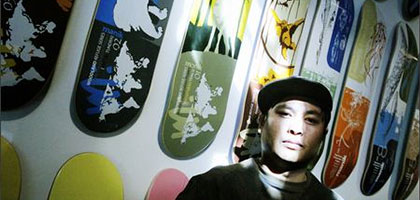
Seattle Photog Gives Up Skating for Yoga, Somehow Retains Credibility
The October 13, 2006 Seattle Post Intelligencer reports in an article titled “Artists bring a fresh expression to skateboarding in ‘Pushin’ 5′ exhibit”:
There was a time when Charles Peterson wasn’t afraid to send himself sailing down the sidewalk, four small wheels and a wooden plank beneath his feet… But these days, at 42, the renowned Seattle photographer no longer slips the skateboard beneath his feet. After all, the body doesn’t bounce like it used to. And when bones break, it means something — especially for a man who relies on unscathed arms and wrists and hands and fingers to go about making his art… “Practicing yoga is more my speed these days,” he said.
Of course it doesn’t hurt that he was at the right place and time to snap some great early pics of Mudhoney, Fugazi, Nirvana and Pearl Jam. I’m almost his age and I need to be able to type to make a living and yet I still skate and take pictures on a weekly basis. It’s jealousy on my part since I’ve never been asked to be in an a skateboard related art show. Don’t make me start my own! Waaaah!
The picture of the curator at the top and these pictures of Charles Peterson’s pictures are credited to Gilbert W. Arias/Seattle Post-Intelligencer. Manik Skateboards is behind the show.
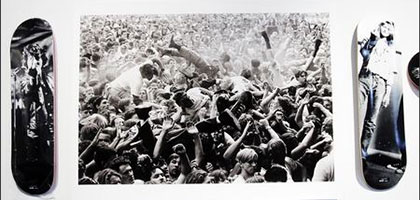
The show runs through November 4 at Blvd Gallery, 2316 Second Ave in Seattle. As long as I’m poaching:
Artists bring a fresh expression to skateboarding in ‘Pushin’ 5′ exhibit
By WINDA BENEDETTI
P-I REPORTERThere was a time when Charles Peterson wasn’t afraid to send himself sailing down the sidewalk, four small wheels and a wooden plank beneath his feet — that thin skateboard the only thing keeping him off the pavement zipping past below.
COMING UP
PUSHIN’ 5
WHAT: Art exhibit
WHEN: Tonight through Nov. 4
WHERE: Blvd Gallery, 2316 Second Ave.
HOURS: 6-9 p.m. Wednesday-Saturday; opening reception tonight at 6
CHECK IT OUT
Regina Hackett’s profile of artist Jesse Edwards at goto.seattlpi.com/288298
It was the 1980s, and in those days gravity could be defied and injury could be denied. Youth, the ultimate shield.
But these days, at 42, the renowned Seattle photographer no longer slips the skateboard beneath his feet. After all, the body doesn’t bounce like it used to. And when bones break, it means something — especially for a man who relies on unscathed arms and wrists and hands and fingers to go about making his art.
“Practicing yoga is more my speed these days,” he said.
And yet tonight, Peterson will ride again. Seven skateboards, each one carrying his famous rock ‘n’ roll photographs on their backs, will be unveiled at the opening of the “Pushin’ 5” exhibit at the Blvd Gallery in Belltown.
The exhibit examines the place where skateboard culture careers headlong into the world of fine art and contemporary graphics. It also celebrates the fifth anniversary for a Seattle skateboard company called Manik, a business that has taken a novel approach to merging the fast-moving physical sport with the more cerebral of visual arts.
“To understand the show, you have to understand Manik Skateboards,” said Nin Truong, who founded the company with Marshall Reid and Eric Green and is co-curating “Pushin’ 5.” “Our original intent was not really to create another skateboard company. What we wanted to do was create a creative outlet.”
Peterson’s famed photographs from Seattle’s grunge heyday — specifically from his “Touch Me I’m Sick” series — stand as the centerpiece of the exhibit. Captured in gritty black and white, there’s Mudhoney and Fugazi. There’s Kurt Cobain and Eddie Vedder. There are shots of ecstatic fans lost in the music, stage divers throwing themselves onto the mercy of the crowd — these images burned onto seven limited-edition skateboard decks, ready to roll.
What does skateboarding have to do with grunge?
Everything.
“It’s a great form of urban expression,” Peterson said. “When you’re skateboarding it’s just one long, constant exercise and, consequently, you’re just in this state of adrenaline the whole time.”
It’s adrenaline that bleeds from those punk-rock pictures of his.
Look at Peterson’s work and it’s clear: The motion, the energy, the raw fury of live punk and grunge seem perfectly suited to the skateboard as a medium. After all, this is a sport that somehow puts the thrash and smash of rock ‘n’ roll into physical form. Skateboarding is rock ‘n’ roll for the body.
“You can almost hear how loud it was there,” said Truong of Peterson’s concert photos.
Truong, a local artist, skateboarder and teacher, is presenting the “Pushin’ 5” exhibit with longtime arts promoter and skateboarder Larry Reid, Marshall’s dad. It’s a follow-up to “The Push Project,” Truong and Reid’s much-lauded skateboard art exhibit that opened in Seattle in 2003 and later appeared in Los Angeles, New York and Portland.
Energizing a gallery
For this latest twist on the idea, Truong, Reid and their fellow conspirators have transformed Blvd Gallery into something of a skateboard shop.
“The skate shop is like the community center for skateboarders,” said gallery owner Damion Hayes. “I like the idea of having that energy in a gallery.”
Skateboards. T-shirts. Paintings. Posters. Skate videos. All the hallmarks of a local board shop have been tweaked a bit, twisted and transformed into fodder for an art exhibit.
The show will feature work not only from Peterson but from many local, national and international artists.
For the purposes of the exhibit, Truong gave some 30 miniature wooden skateboards to a variety of artists — skaters and non-skaters alike — and asked each to do with the boards what they would. Artists such as Joe Newton, Yoshi Obayashi, George Estrada, Iosefatu Sua and Jesse Edwards are among those who got creative with their small wooden canvases.
Seattle artist Shawn Wolfe examined the intersection of skateboarding and commerce, carving a bold “SOLD” into his miniboard.
Much of Wolfe’s work lately has played with language and signs and what they signify. And so he contributes to “Pushin’ 5” a painting called “Human Highway.” Here, a man gulps gasoline directly from the pump. Gas guzzler, indeed. It’s an eerie statement about our times.
Wolfe had never designed art for a skateboard before he was asked to bring his vision to a skateboard deck for the original “Push Project.” He created a board called “In Black Helicopters We Trust.”
“Designing a skateboard for the first show was really exciting and comparable to the first time I got to design an album cover or a CD cover,” Wolfe said.
For him, it was a unique challenge — working with the unusual size and format, having his work carried around by skaters, used and abused. “It was different from anything else I’ve done,” he said.
A Manik force
The “Pushin’ 5” exhibit, the skateboards — all of this has sprung from the creative wellspring that is Manik, a Seattle skateboard manufacturer and a major creative force behind skateboarding culture.
Manik has established an artist-in-residence program to bring into the skateboarding world great artists who had not necessarily been associated with the skateboard community yet somehow created work that spoke to the culture.
As part of the program, artists are commissioned to design the artwork for five skateboard decks. Each artist in residence is given creative freedom; they can do what they please, there is no direction from Manik. The only confines are the size of the board — 8 inches wide by 32 inches long. Manik then produces a limited run of the boards and sells them.
“I go out there and I search for people that I think might be interesting and have a different background than what you would typically use for skateboard graphics and then have them explore this medium,” explained Truong, who also teaches landscape architecture and public art at the University of Washington.
In doing this, he hopes to expose the skateboard community to art beyond the kind typically found on boards while also exposing the art world to the skate community.
The “Pushin’ 5” exhibit will showcase the boards created by each of Manik’s artists in residence. One of the standout series of five comes from Brooklyn artist Maya Hayuk — bold blacks and reds and oranges, swirling lines, birds, hands, woodlike patterns, all of it pretty with a touch of something dark.
The show also will feature eight boards made for the original “Push Project.”
“What we’re attempting to do is mimic the sort of atmosphere and environment of an urban skate shop and sort of draw attention to the creative aspects of urban skateboard culture and the pop-culture influences that are reflected in skateboard culture,” said Reid, who at 53 hasn’t given up skateboarding and has the road rash to prove it.
“I think it’s real interesting how all these pop-culture and fine-art influences have been assimilated. It’s really accessible but it’s deceptively sophisticated.”


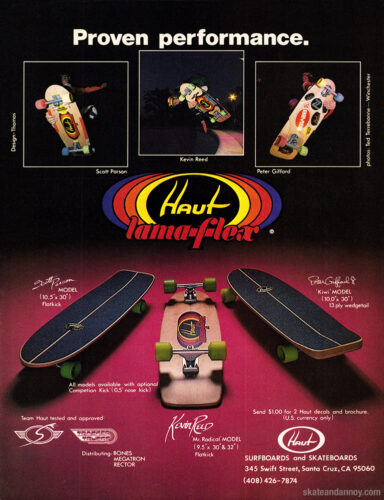
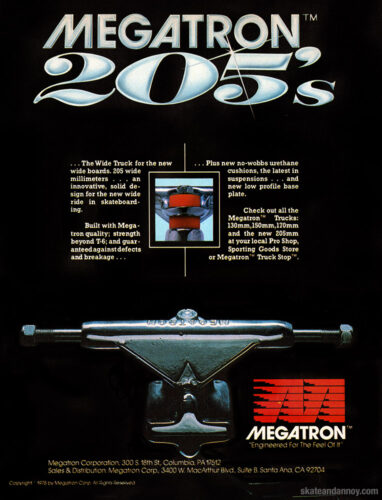
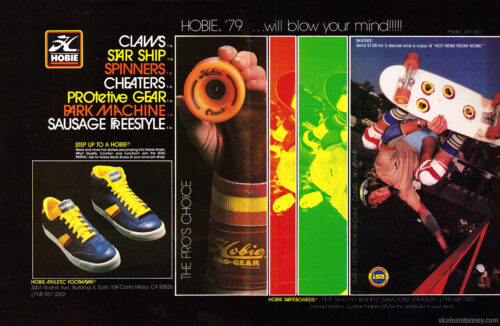





I think a few more dudes should give it up. Park
he needs a hat that says “old fart”, and i agree with mc